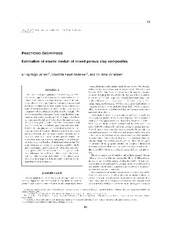Estimation of elastic moduli of mixed porous clay composites
Peer reviewed, Journal article
Published version
Permanent lenke
https://hdl.handle.net/1956/5188Utgivelsesdato
2011-01-13Metadata
Vis full innførselSamlinger
- Department of Earth Science [1050]
Sammendrag
We have developed a procedure for estimating the effective elastic properties of various mixtures of smectite and kaolinite over a range of confining pressures, based on the individual effective elastic properties of pure porous smectite and kaolinite. Experimental data for the pure samples are used as input to various rock physics models, and the predictions are compared with experimental data for the mixed samples. We have evaluated three strategies for choosing the initial properties in various rock physics models: (I) input values h ave th e sa me porosit y, (2) input values have the same pressure, and (3) an average of (I) and (2). The best results are obtained when the elastic moduli of the two porous constituents are defined at the same pressure and when their volumetric fractions are adjusted based on different compaction rates with pressure. Furthermore, our strategy makes the modeling results less sensitive to the actual rock physics model. The method can help obtain the elastic properties of mixed unconsolidated clays as a function of mechanical compaction. The more common procedure for estimating effective elastic properties requires knowledge about volume fractions, elastic properties of individual constituents, and geometric details of the composition. However, these data are often uncertain , e.g., large variations in the mineral elastic properties of clays have been reported in the literature, which makes our procedure a viable alternative.
